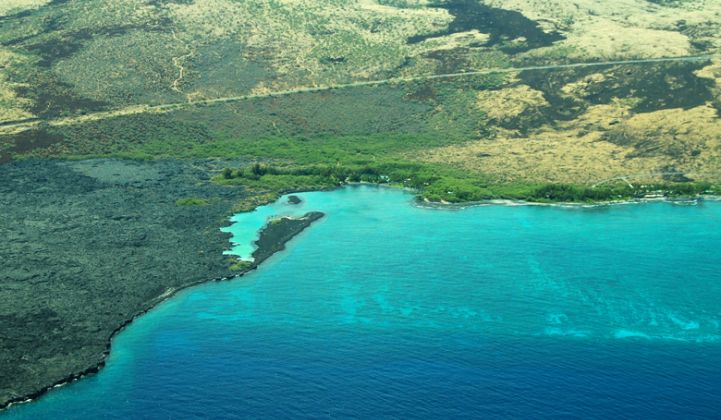Hawaii is a perfect test bed for the proposition that solar and wind power, backed by a significant amount of energy storage, can become the primary source of electricity for an entire island grid -- or at least a luxury resort or two.
Take this week’s announcement of what could be the biggest battery ever ordered up by a private citizen -- a 1 megawatt-hour system from startup Aquion, backing up the residence and working farm of Medtronic founder Earl Bakken. The off-grid property will replace two propane generators with 176 kilowatts of solar, and enough battery capacity to keep the Kona coast property running for up to three days of cloudy skies.
It’s the biggest order yet for Aquion, which has brought in more than $150 million in equity, debt and grant financing to fund development and production of its sodium-ion battery systems. The Pittsburgh-based startup claims its batteries can achieve a round-trip energy efficiency of 85 percent, last for more than a decade, and come in at an eventual price point of less than $300 per kilowatt-hour -- an aggressive target, although that’s just for the batteries, not for the inverters and other balance-of-systems costs.
A megawatt of batteries for 176 kilowatts of solar is still an expensive way to stay off-grid in comfort, however, no matter how cheap the batteries. “This really shows if you want to have grid-quality power at your house, this is the kind of system that allows you to do it,” Ted Wiley, vice president of product and corporate strategy for Aquion, said in an interview this week. The partners, including local developer Renewable Energy Systems (RES), didn’t disclose financial details on the project, but it’s likely out of reach for most grid-connected customers.
Still, with retail electricity rates in Hawaii running from 45 cents for average users to as high as $1 per kilowatt-hour for power-hungry commercial and industrial customers, the state is one of the few energy markets where battery-backed solar as an alternative to the grid is starting to make sense, he said.
“There are instances where the sun is good enough, and the batteries are getting to the right price point,” he said. Aquion is working with local distributors or dealers in every utility jurisdiction in Hawaii right now, looking for smaller-scale battery-solar opportunities, he said.
Hawaii’s growing market for grid batteries is being driven by the high price of electricity, largely generated by imported oil, and by the growing disruptions of wind and solar power. Multi-megawatt batteries on Oahu and Maui are backing up wind farms and helping to balance grid power at key distribution substations. Hawaiian Electric is soon to announce up to 200 megawatts of energy storage projects to help integrate wind and solar on Oahu, and it’s also deploying 1 megawatt of distributed batteries with startup Stem.
The Rocky Mountain Institute identified Hawaii as the first U.S. market to face “grid defection” by customers able to pay less for their own solar-generated, battery-banked power than what the utility is charging. The tricky thing about this concept is that it doesn’t make sense for a grid-connected customer to buy the hours of battery storage they’d need to live off-grid.
As RMI noted, it’s better for each battery to be sized and located just right, to help the utility and customers alike. The lithium-ion batteries from solar providers like Sunrun and SolarCity are designed to provide a few hours of backup, not 24/7 operations, and Stem’s batteries pay their way by shaving peaks in power usage, not keeping a building running all day.
Hawaii has a few more microgrids in the works. Larry Ellison has hired University of California, San Diego microgrid expert Byron Washom to remake his resort on the island of Lanai as a solar-powered paradise that desalinates its own water. On the Big Island, the Parker Ranch, a working cattle ranch, is collaborating with the town of Waimea on a plan to tap geothermal, solar and wind resources to power their own grid.
In a larger sense, each of Hawaii’s islands is its own microgrid, whether it’s a virtually private one, or one shared by millions of Honolulu residents. The Hawaii Public Utilities Commission has demanded that Hawaiian Electric, the state's biggest investor-owned utility, improve its approach to solar PV integration, develop a demand response plan, and improve grid reliability on Oahu and other islands are taking on similar challenges. It will be interesting to see how NextEra Energy, the big solar and wind developer that’s buying HECO holding company Hawaiian Electric Industries for $4.3 billion, will take on these challenges -- and how Hawaii's increasing number of semi-energy-independent customers will play a role.



